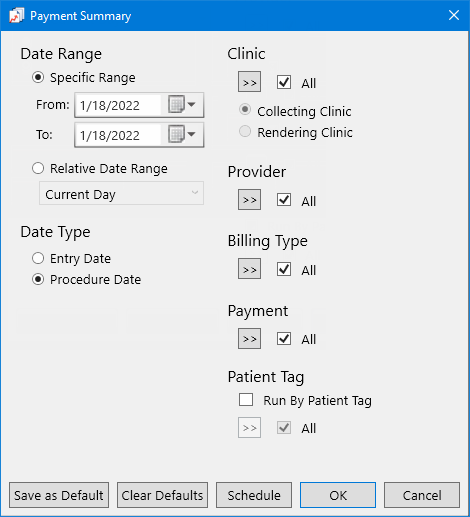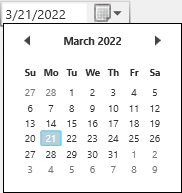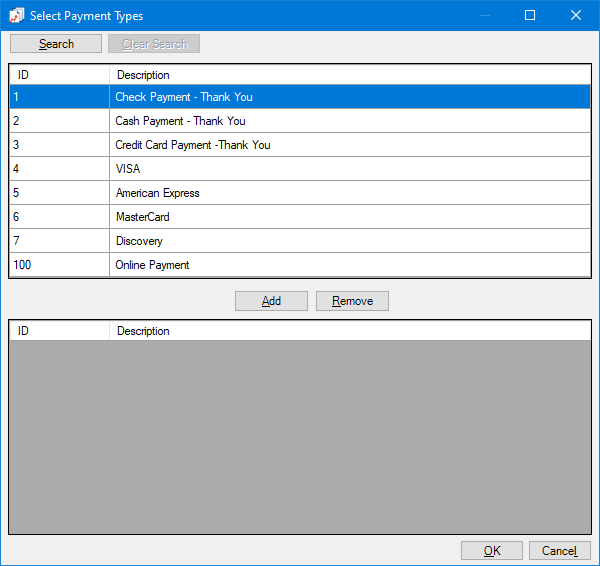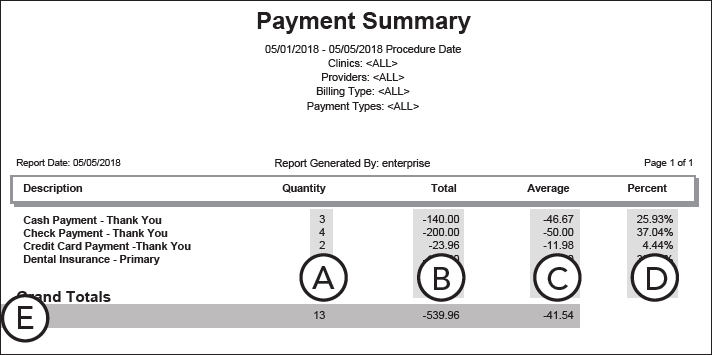The Payment Summary Report displays totals by payment type.
|
Why: |
To verify bank and credit processing statements, to compare collection agencies, and to view payment totals by payment types |
When: |
As needed |
To generate the report
In DXOne Reporting, select Analysis, and then double-click Payment Summary.
The Payment Summary dialog box appears.

Set up the following options:
Date Range - To filter the report by date, do one of the following:
To include payments that have dates (based on the Date Type) within a range that you specify, select the Specific Range option. With this option selected, do one of the following:
Enter a date range (in a m/d/yyyy format) in the From and To boxes.
To select a date, do the following for From and To:
Click the corresponding calendar icon to view a month calendar.

Navigate to the correct month using the left and right arrows.
Note: To quickly change the year and month, click the month-year at the top of the calendar, navigate to the correct year using the left and right arrows, and then click the correct month.
Click the correct day.
To include payments that have dates (based on the Date Type) within a range that is relative to the report date, select the Relative Date Range option. With this option selected, select one of the following relative date ranges from the list:
Current Day Current MTD Current Fiscal YTD Current Calendar YTD |
Previous Day Previous Week Previous Month Previous 3 Months Previous 6 Months Previous Fiscal Year Previous Calendar Year |
Next Day Next Week Next Month Next 3 Months Next 6 Months Next Fiscal Year Next Calendar Year |
Date Type - Select one of the following options:
Entry Date - To include a payment based on the date that it was created (entered into the database).
Procedure Date - To include a payment based on the date that was specified for it.
Note: Most of the time, a payment will have the same entry and procedure date. They will differ only if you backdate the payment.
Clinic - To filter the report by the clinics that are associated with payments (based on either the collecting or rendering clinic), do one of the following:
To include all clinics that you are allowed to generate the report for, select the All checkbox.
Note: The full amount of a payment (fully or partially applied) may be included on the report.
To include specific clinics, do the following:
Click the search button  .
.
The Select Clinics dialog box appears.

Note: Only the clinics that you are allowed to generate the report for are available.
If the list is long, to search for a clinic by ID and/or title, do the following:
Click Search.
The options for searching appear in the upper list.

Enter the first character or more of a clinic's ID and/or title in the ID and Practice Title boxes, respectively.
Click Show Results to view a list of matching clinics.
Note: To return to viewing the list of all the clinics, click Search, click Clear Search to clear the search criteria that you entered, and then click Show Results.
In the upper list, select one or more clinics.
Note: To select multiple clinics, click a clinic, and then, while pressing the Ctrl key, click the other desired clinics. To select a range of adjacent clinics, click the first clinic of the desired range of clinics, and then, while pressing the Shift key, click the last clinic of the desired range of clinics.
Click Add.
Repeat steps b-d as needed to add other clinics.
Note: To remove a clinic that you added, select that clinic in the lower list, and then click Remove.
Click OK.
Also, if you are running the report for specific clinics, select one of the following options:
Collecting Clinic - To include the applied amount of a payment (fully or partially applied) if its collecting clinic is one of the specified clinics for the report.
Rendering Clinic - To include the applied amount of a payment (fully or partially applied) if the rendering clinic of the charge that it's applied to is one of the specified clinics for the report.
Note: The Collecting Clinic and Rendering Clinic options are available only if the All checkbox for Clinic is clear, indicating that specific clinics are selected.
Provider - To filter the report by the providers that are associated with payments, do one of the following:
To include all providers that you are allowed to generate the report for, select the All checkbox.
Note: The full amount of a payment (fully or partially applied) may be included on the report.
To include specific providers, do the following:
Click the search button  .
.
The Select Providers/Staff dialog box appears.

Note: Only the providers and staff that you are allowed to generate the report for are available.
If the list is long, to search for a provider by ID, first name, last name, and/or title, do the following:
Click Search.
The options for searching appear in the upper list.

Enter the first character or more of a provider's ID, first name, last name, and/or title in the ID, First Name, Last Name, and Title boxes, respectively.
Click Show Results to view a list of matching providers and staff members.
Note: To return to viewing the list of all the providers and staff members, click Search, click Clear Search to clear the search criteria that you entered, and then click Show Results.
In the upper list, select one or more providers.
Note: To select multiple providers, click a provider, and then, while pressing the Ctrl key, click the other desired providers. To select a range of adjacent providers, click the first provider of the desired range of providers, and then, while pressing the Shift key, click the last provider of the desired range of providers.
Click Add.
Repeat steps b-d as needed to add other providers.
Note: To remove a provider that you added, select that provider in the lower list, and then click Remove.
Click OK.
Note: The applied amount of a payment (fully or partially applied) may be included on the report if the rendering provider of the charge that it's applied to is one of the specified providers for the report.
Billing Type - To filter the report by the billing types that are associated with patients who have payments entered in their records, do one of the following:
To include all billing types, select the All checkbox.
To include specific billing types, do the following:
Click the search button  .
.
The Select Billing Type dialog box appears.

If the list is long, to search for a billing type by ID and/or description, do the following:
Click Search.
The options for searching appear in the upper list.

Enter the first character or more of a billing type's ID and/or description in the ID and Description boxes, respectively.
Click Show Results to view a list of matching billing types.
Note: To return to viewing the list of all the billing types, click Search, click Clear Search to clear the search criteria that you entered, and then click Show Results.
In the upper list, select one or more billing types.
Note: To select multiple billing types, click a billing type, and then, while pressing the Ctrl key, click the other desired billing types. To select a range of adjacent billing types, click the first billing type of the desired range of billing types, and then, while pressing the Shift key, click the last billing type of the desired range of billing types.
Click Add.
Repeat steps b-d as needed to add other billing types.
Note: To remove a billing type that you added, select that billing type in the lower list, and then click Remove.
Click OK.
Payment - To filter the report by payment type, do one of the following:
To include all payment types, select the All checkbox.
To include specific payment types, do the following:
Click the search button  .
.
The Select Payment Types dialog box appears.

If the list is long, to search for a payment type by ID and/or description, do the following:
Click Search.
The options for searching appear in the upper list.

Enter the first character or more of a payment type's ID and/or description in the ID and Description boxes, respectively.
Click Show Results to view a list of matching payment types.
Note: To return to viewing the list of all the payment types, click Search, click Clear Search to clear the search criteria that you entered, and then click Show Results.
In the upper list, select one or more payment types.
Note: To select multiple payment types, click a payment type, and then, while pressing the Ctrl key, click the other desired payment types. To select a range of adjacent payment types, click the first payment type of the desired range of payment types, and then, while pressing the Shift key, click the last payment type of the desired range of payment types.
Click Add.
Repeat steps b-d as needed to add other payment types.
Note: To remove a payment type that you added, select that payment type in the lower list, and then click Remove.
Click OK.
Patient Tag - Do one of the following:
To not filter the report by a patient tag, clear the Run By Patient Tag checkbox.
To filter the report by the tags that are assigned to patients, select the Run By Patient Tag checkbox. With this checkbox selected, the options to filter the report by tag are available. Do one of the following:
To include payments for patients with any patient tag, select the All checkbox.
To include payments for patients with specific tags, do the following:
Click the search button ![]() .
.
The Patient Tag Selection dialog box appears.

If the list is long, to search for a patient tag, do the following:
Click Search.
The options for searching appear in the upper list.

Enter the first character or more of a patient tag name in the Tag Name box.
Click Show Results to view a list of matching patient tags.
Note: To return to viewing the list of all the patient tags, click Search, click Clear Search to clear the search criteria that you entered, and then click Show Results.
In the upper list, select one or more patient tags.
Note: To select multiple patient tags, click a patient tag, and then, while pressing the Ctrl key, click the other desired patient tags. To select a range of adjacent patient tags, click the first patient tag of the desired range of patient tags, and then, while pressing the Shift key, click the last patient tag of the desired range of patient tags.
Click Add.
Repeat steps b-d as needed to add other patient tags.
Note: To remove a patient tag that you added, select that patient tag in the lower list, and then click Remove.
Click OK.
Click Save as Default to save the current settings for the next time you run the report.
Click Clear Defaults to revert the dialog box options to the original defaults.
Click Schedule to schedule a report job.
Click OK to preview the report.

Important information this report provides
Quantity - The number of payments that were received.
Total - The total dollar amount of payments that were received.
Average - The average payment amount (Total / Quantity).
Percent - The payment total compared to all payments (Total / Total Of All Payments). The percent column assists you in comparing the most popular payment types. The higher the percentage, the more revenue was brought in by the payment type.
Grand Totals - This section includes the quantity, total, and average for all the payments on the report.